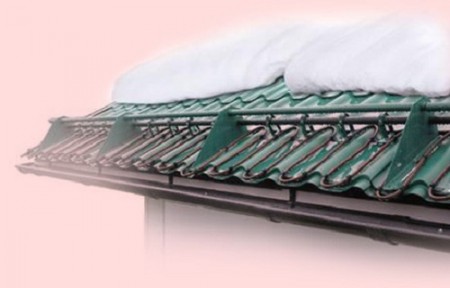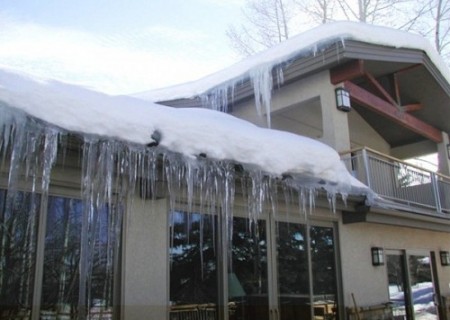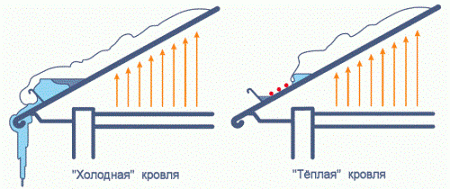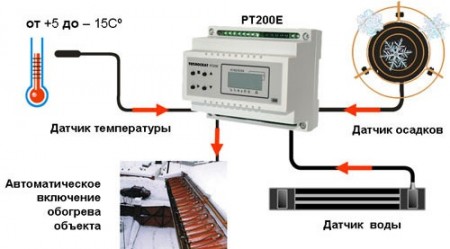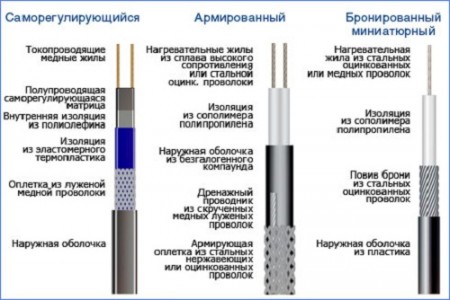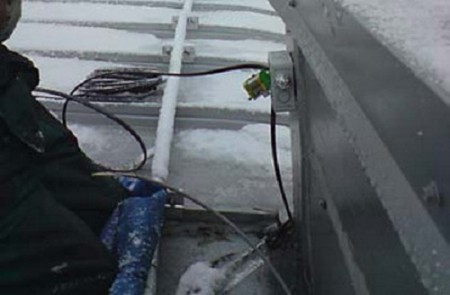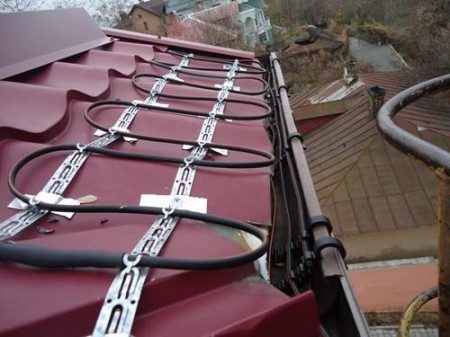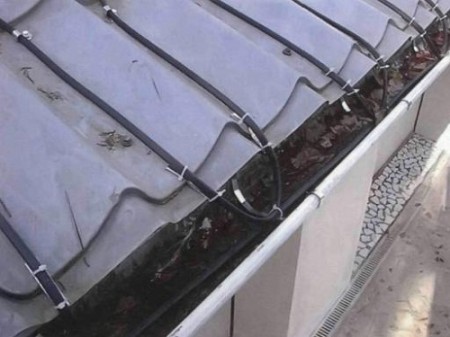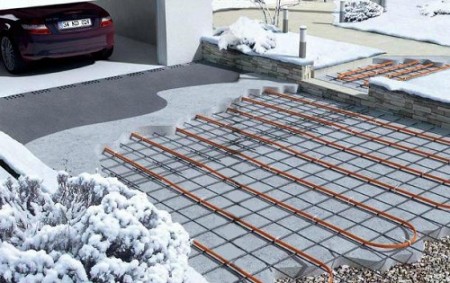Snow, which eventually turns into ice, gradually destroys the roof covering, drainage, various communications that are on the roof. The formation of ice and icicles on the roof threatens not only the cars standing near the buildings, but also the health and lives of people. Usually, the roofs from ice are cleaned manually - with crowbar and shovel, which, of course, does not contribute to the durability and reliability of the roofing. To effectively prevent and combat the formed ice, anti-icing roof systems are used.
Content
Anti-icing systems - is there any sense?
Since the winter in most of our country is severe enough, temperature differences are significant, frosts alternate with frequent thaws, a thick layer of ice interspersed with snow quickly forms on the roofs. This is a real problem, when drainage and drain pipes are jammed with ice, water begins to search for the path, destroys the walls and elements of drainage systems.
Icicles and whole lumps of snow regularly fall from a great height, they can seriously damage a car or other property, and kill a person. In Russia, with ice, they mostly fight, armed with crowbar, shovel and scraper. With this approach, the surface of the roof every season receives many "injuries" of varying severity, which entails significant financial costs for its repair.
In this case, it is advisable to spend money once for the purchase and installation of a modern anti-icing system, and get rid of the problem.
The advantages are obvious: the system provides permanent heating of the roof, preventing the formation of ice, which in turn, prolongs the life of the roof, drainpipes and gutters, protects the walls and facade from premature failure. Icicles and snowdrifts falling on the heads of passers-by.
Anti-icing system is installed on the finished roof, connect, and then it works completely independently. Heating, thanks to special sensors, is turned on only during the possible formation of ice, and switches itself off as soon as the roof is completely cleared of ice.
The main element of the anti-icing system is the heating cable. It is reliable and safe, resistant to temperature changes, sunlight and precipitation.
"Heated roof" - efficiency and economy
All the obvious advantages of anti-glare systems we have already listed above - this is the extension of the service life of the roof and gutters, preservation of the property, health and life of people. Choosing the appropriate equipment, experts advise to take into account the features of the roof construction, and only then pay attention to the price.
Anti-icing systems are often installed at gas stations and on the roofs of children's institutions - schools and kindergartens, thus ensuring the safety of children.
In addition to the roof, anti-icing systems protect from the drain pipes. Heating of the roof and gutters is necessary, in particular, when the drain is located inside a residential heated house. Pipes need to be heated in places where ice may form, as water can flood a dwelling. If the drain pipe goes into the sewer, then the heating is set to the depth of freezing of the earth.
The heating cable must be protected as much as possible from damage that it can get when sliding melting snow and ice. So, directly on the roof, the cable is protected by a closed gutter or sheets of metal. Thus, the heating cable does not spoil the appearance of the roof, it is reliably protected, and, moreover, does not interfere with the cleaning of the roof from debris and fallen leaves.
How the anti-icing system works
The device is for our country is relatively new, has appeared recently, but already enjoys quite a large demand. The main task of the roof heating system is to ensure unimpeded drainage of melt water through specially designed drainage channels. Anti-icing systems work also in conditions of heavy snowfall, at temperatures from +3 to -15 degrees Celsius. At lower temperatures, snow falls quite rarely, but there are high-power systems on sale that work in very severe frosts.
To ensure that the anti-icing system works as efficiently as possible, a number of factors need to be taken into account when selecting and installing it:
- The preferred direction and strength of the winds in a particular place.
- Location of the slopes of the roof relative to the parts of the world.
- The intensity of heating the roof with sun rays.
Anti-icing system consists of:
- Heating element - cable and fasteners.
- Distribution system and power supply system, consisting of control and power cables, as well as distribution connections.
- Sensors of the control system that monitor the level of humidity, temperature, and control the operation of the system as a whole.
- Elements of the control system that are mounted inside the building: control cabinet, humidity sensors, various thermostatic settings and start-up devices.
As we have already mentioned, the main element of the system is the heating cable for heating the roofs, which, in fact, eliminates icing.
There are several types of heating cables on sale:
cable with constant resistance
A cable of constant resistance, or a resistive cable, has good and stable power and resistance over its entire length. The cable consists of an outer sheath, an insulation and a metal conductor. There are several types of resistance cables - zoned and armored. Zone cable is best used for heating the drainage, which is of great length and with wide drainpipes.
The armored cable will be appropriate for installing the heating of a flat reinforced concrete roof, since it is much more resistant to temperature differences than the zonal one. Resistive cable has many important advantages - it's high heat dissipation, elasticity, the ability to lay the cable in several layers.
But there are drawbacks. So, a constant resistance along the entire length of the cable inevitably leads to unnecessary electricity costs. And if we take into account the fact that the need for heating level is different at different sections of the roof, this feature of the cable can be safely considered a serious drawback. In addition, the roof should be periodically cleaned of debris and leaves, and the cable will be strongly interfered with.
self-regulating cable
The heat that separates this type of cable generates a polymer matrix-semiconductor with carbon filler. The design features of the self-regulating cable allow heating of different intensity throughout the cable system, taking into account the temperature and environmental conditions in which the cable is laid.
The power of the cable is calculated based on the conditions of the local climate, the material of the roof, and the type of thermal insulation. In general, cables with a heat release of 20-30 W / m and a power of 250 W are used.
Installation of anti-icing system
For installation, a variety of fasteners made of metal or plastic are used. For drainpipes, hooks and cables are used. For the roof - mounting tape. All fasteners must be very durable and reliable.
How to fix the cable to the roof or drainage systems depends to a large extent on the material of the roof and downpipes. It is important not to forget: any damage to the integrity of the roof is unacceptable.
For fixing, rivets are sometimes used, but only when installing the cable in gutters, where it is impossible to secure the cable in any other way. Inside the drainpipes, the cable is suspended from the cable.
The whole system is equipped with temperature sensors, and thermostats. The result is something like climate control. Automation independently controls the operation of the entire system, adjusting the temperature to the climate, location and number of storeys of the building.
Heating starts only when the temperature drops below +5 degrees, and there is water on the roof or in the drain. This mode allows you to save a lot on electricity, do not disconnect the system from power, and, moreover, do not dismantle it for the summer.
When designing an anti-icing system, it is necessary to try to make it as cheap, effective and harmless to the roofing material. And, of course, try to make sure that the installed equipment does not spoil the appearance of the house.
After the system is installed, it is immediately tested. To do this, simulate signals from the sensors, check the operation of the control system, make a trial run. Tests are conducted most often in early autumn. The insulation of the cable is carefully checked for damage. After the system has been fully tested, it is turned on in the operating mode. After that, the system remains in the standby mode.
In conclusion, we can say that the anti-icing system can be used not only for heating roofs. The cable can be laid in the path in the yard, heating a small area, access to the garage, etc. In this case, it is possible to use not only a cable, but also special hoses, through which the heated liquid circulates.



